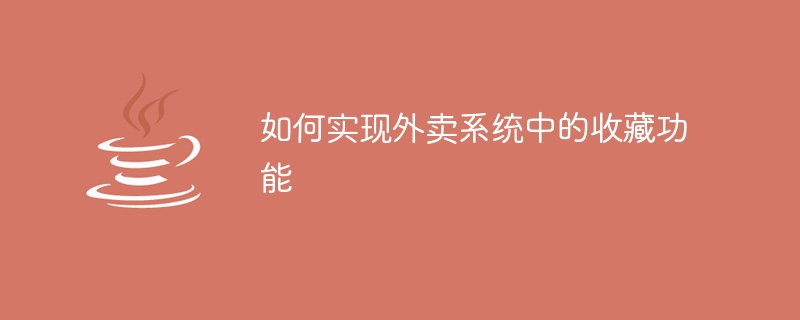Home >Java >javaTutorial >How to implement the collection function in the takeout system
How to implement the collection function in the takeout system
- PHPzOriginal
- 2023-11-01 15:46:46913browse

With the development of society and the improvement of living standards, takeout has become a part of many people’s daily diet. In order to meet the needs of consumers, food delivery platforms continue to introduce new features and new features to attract users. In the takeout platform, the collection function is a very important and popular function. This article will introduce how to implement the collection function in the takeout system.
First of all, what is the role of the collection function in the takeout system? In takeout platforms, sometimes users may have multiple favorite restaurants or dishes, but cannot order immediately due to time or other reasons. At this time, the collection function is very useful. Users can collect their favorite restaurants or dishes to quickly find and place orders in the future, improving user experience and efficiency.
So how to implement the collection function?
- User login: First, in order to realize the collection function, the user needs to log in to the account of the takeout platform. Only after the user logs in can the system associate the user's collection records with the corresponding account.
- Favorite button: Add a favorite button on the restaurant or dish details page of the takeout platform. When the user clicks this button, the system will add the restaurant or dish to the user's favorites list.
- Favorite list: Add a favorite list to the user's personal center or personal information page to display the user's favorite restaurants or dishes. Users can view and manage their favorite records in this list.
- Cancel favorites: In the favorites list, add a cancel favorite button for each favorite restaurant or dish. When a user no longer likes or needs to favorite a restaurant or dish, he or she can remove it from the favorites list by clicking the Cancel Favorite button.
- Message Reminder: When a user’s favorite restaurant or dish has new promotions or coupons, the user can be notified through in-site messages, text messages or push notifications to remind the user to order in time.
- Data statistics: The collection function is also a function that can bring user behavior data. The takeout platform can count users' collection preferences, understand users' tastes and preferences, and then recommend similar or other related restaurants or dishes to users.
Of course, the above is just the basic framework for realizing the collection function, and many improvements and optimizations can be made in specific operations and details. For example, adding a favorites classification function allows users to classify and organize their favorite restaurants or dishes; adding a favorites sharing function allows users to share their favorites lists with friends or other users. In short, implementing the collection function in the takeout system can provide users with better user experience and services, and improve user satisfaction and loyalty.
In today's fiercely competitive world of food delivery, if you want to gain more users and market share, you not only need to provide high-quality restaurant and dish selections, but you also need to introduce and improve more user-friendly functions. User needs. As an important function in the takeout system, the collection function can bring users a convenient and fast ordering experience. It can also bring more user activity and user insights to the takeout platform, thereby providing support for the development and growth of the platform. and reference. Whether it is for users or takeout platforms, implementing the collection function in takeout systems is a very valuable and necessary function.
The above is the detailed content of How to implement the collection function in the takeout system. For more information, please follow other related articles on the PHP Chinese website!

